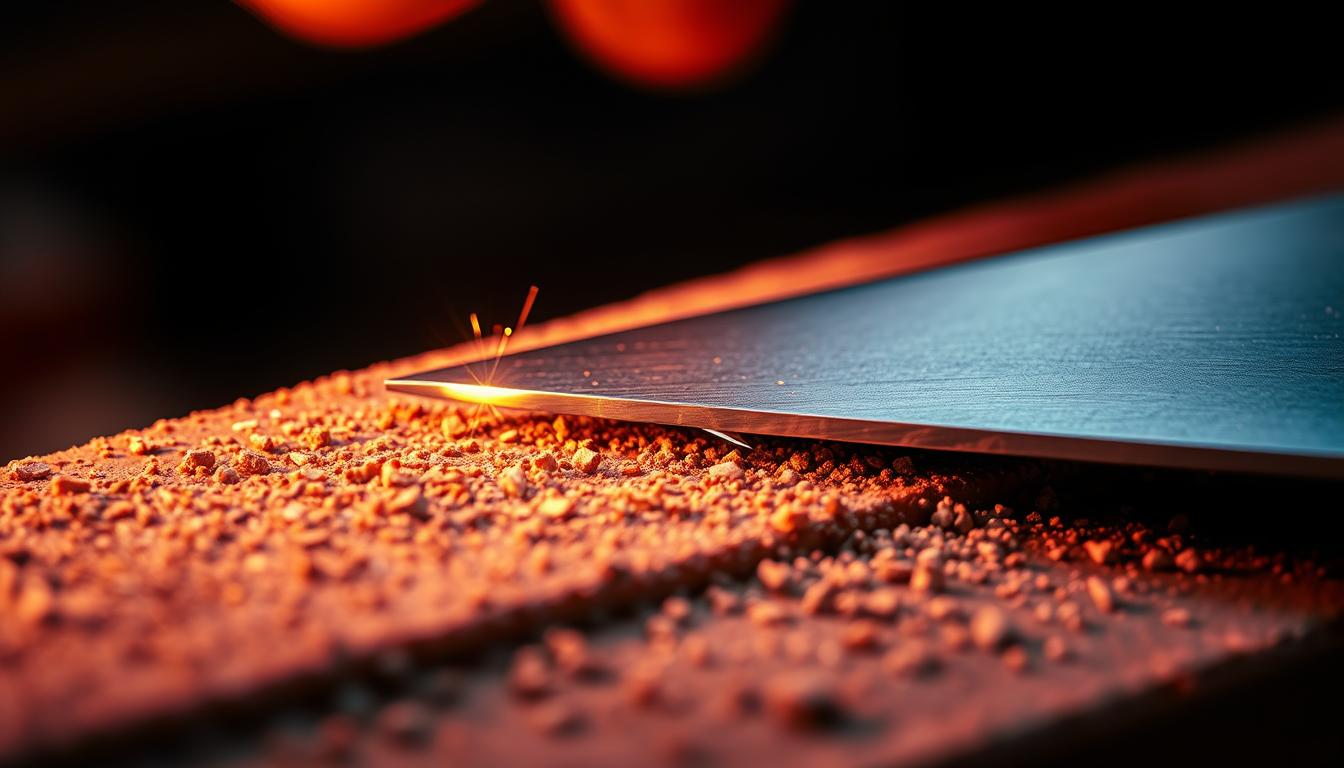Did you know a 1-degree difference in blade geometry can determine whether your edge lasts weeks or months? Most users never realize their tools lose 40% of cutting efficiency within just 10 uses due to improper angle maintenance.
Every sharpened tool operates on a scientific principle: thinner edges slice better but wear faster. This explains why delicate tasks demand precise 17-degree profiles, while rugged jobs require 30-degree resilience. The measurement starts at one side – a “20-degree edge” means each face meets at 40 degrees total.
Cultural traditions shape these choices profoundly. Compare European chef tools with their Japanese counterparts – one prioritizes durability for bone contact, the other excels in precision slicing. Your steel’s hardness (measured in Rockwell C) further dictates what angles it can sustain without chipping.
Key Takeaways
- Edge measurements count each side separately, doubling for total sharpness
- Western blades typically use higher angles than Asian designs
- Softer steels require more obtuse angles for edge retention
- Delicate tasks demand sub-20° angles, heavy-duty needs over 30°
- Proper maintenance restores microscopic “teeth” along the edge
Your cutting needs – not marketing claims – should guide angle selection. A woodcarver’s chisel and survival tool require fundamentally different approaches, just as a sushi master’s blade differs from a butcher’s workhorse. Master this balance, and you’ll transform how your tools perform.
Fundamentals of Knife Angles and Blade Geometry
Your blade’s effectiveness depends on three geometric factors you’ve probably never considered. These elements work together to determine how tools slice, chop, or pierce materials. Let’s break down what makes edges perform differently across various tasks.

Bevel Basics and Edge Variations
The bevel angle acts like your blade’s fingerprint. Grind it at 15 degrees, and you’ll get surgical precision. Bump it to 30 degrees, and durability skyrockets. Each degree change alters how the edge interacts with materials.
Four primary grind types dominate tool design:
| Grind Type | Best Use | Edge Characteristic |
|---|---|---|
| Flat | Slicing vegetables | Balanced sharpness |
| Hollow | Shaving/paper-thin cuts | Razor sharpness |
| Convex | Chopping wood | Maximum strength |
| Compound | Everyday carry tools | Enhanced durability |
Thickness Meets Performance
Blade thickness impacts cutting resistance more than most realize. Thin profiles (0.08″) glide through soft materials, while thicker spines (0.15″) handle heavy impacts. The taper – how the metal narrows toward the edge – determines wedging efficiency.
Your edge apex – where both sides meet – should match your tasks. Delicate work needs a 0.0002″ wide apex, while rugged use requires 0.001″ for chip resistance. Compound grinds solve this dilemma by combining a sturdy primary bevel with a refined secondary edge.
Exploring Knife Angles Explained: Science of Sharpness
Every cutting task demands a precise compromise between two critical factors. Your blade’s longevity and effectiveness depend on harmonizing these opposing forces through calculated angle selection.

Balancing Sharpness With Durability
Thinner edges slice effortlessly but chip faster. This principle explains why straight razors use 7-8 degrees for facial hair, while axes need 30+ degrees. Consider these guidelines:
- 10-15°: Delicate slicing (fish, herbs)
- 17-22°: All-purpose kitchen use
- 22-30°: Heavy-duty tools facing impact
How Usage and Steel Hardness Influence Angle Choices
The Rockwell C Scale determines your steel‘s limits. Harder metals (60+ HRC) maintain sharpness longer but require careful handling. Compare these common pairings:
| Hardness (HRC) | Ideal Angle | Common Uses |
|---|---|---|
| 54-58 | 20-25° | Camping knives |
| 59-62 | 15-18° | Chef’s knives |
| 63+ | 12-15° | Specialty slicers |
Softer materials tolerate wider angles that resist damage. Always match your edge geometry to both your steel properties and intended cutting challenges.
Sharpening Techniques, Tools, and Maintenance
The secret to lasting sharpness lies in your sharpening routine. Three primary methods dominate edge care, each serving distinct purposes based on your tools and skill level.
Comparing Whetstones, Sharpeners, and Guided Systems
Whetstones remain unmatched for precision work. Diamond-coated versions cut faster on hard steels, while ceramic stones polish delicate edges. Consider this comparison:
| Tool | Best For | Learning Curve |
|---|---|---|
| Whetstones | Custom edge angles | High |
| Pull-through sharpeners | Quick touch-ups | Low |
| Guided systems | Repeatable results | Medium |
Step-by-Step Process for Optimal Edge Restoration
Start with 400-grit stones to reshape dull edges. Maintain consistent pressure as you slide the blade from heel to tip. Alternate sides every 5 strokes until a burr forms.
Progress through grits systematically: 1000 for refining, 3000 for polishing. Finish with leather stropping to remove microscopic burrs. Always match stone type to your steel hardness – water stones suit high-carbon blades better than oil variants.
Tips for Maintaining Your Tool and Prolonging Blade Life
- Use honing rods weekly to align edges
- Store blades in dry, protected spaces
- Avoid cutting frozen foods or bones
For emergency touch-ups, ceramic mug bottoms work at 20-degree angles. Remember: proper maintenance reduces full sharpening needs by 60%. Invest in quality systems upfront to save time and preserve your blades.
Conclusion
The perfect edge walks a tightrope between two worlds. Sharpness lets you glide through tasks effortlessly, while durability ensures your tool withstands repeated use. Mastering this balance transforms how your blades perform daily.
Professional services excel by matching steel composition to precise geometry. They use progressive grits to refine edges without weakening the metal’s structure. This approach preserves your blade’s life while maintaining peak performance.
Your maintenance routine matters as much as initial sharpening. Regular honing realigns microscopic teeth along the edge, delaying full resharpening. Store blades properly and avoid harsh materials to prevent unnecessary damage.
Remember: no universal solution exists for every cutting challenge. Outdoor tools demand different care than kitchen instruments. By understanding these principles, you’ll make smarter choices that extend your gear’s effectiveness for years.



